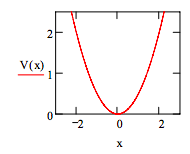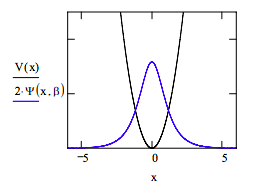10.18: Trigonometric Trial Wave Function for the Harmonic Potential Well
- Page ID
- 136257
Definte potential energy: V(x) := \( \frac{s^2}{2}\)
Display potential energy:

Choose trial wave function: \( \Psi (x, \beta ) := \sqrt{ \frac{ \beta}{2}} sech( \beta x)\)
Set up variational energy integral:
\( E( \beta ) := \frac{ \int_{- \infty}^{ \infty} \Psi (x, \beta ) \frac{-1}{2} \frac{d^2}{dx^2} \Psi (x, \beta ) dx + \int_{- \infty}^{ \infty} \Psi (x, \beta ) \frac{x^2}{2} \Psi (x, \beta ) dx}{ \int_{0}^{ \infty} \Psi (x, \beta )^2 dx} |^{assume,~ \beta > 0}_{simplify} \rightarrow \frac{1}{24} \frac{4 \beta ^2 + \pi^2}{ \beta^2}\)
Minimize the energy integral with respect to the variational parameter, \( \beta\).
\( \beta\) := 0.2 \( \beta\) := Minimize (E, \( \beta\)) \( \beta\) = 1.253 E( \(\beta \)) = 0.524
Display wave function in the potential well.

Calculate the probability that the particle is in the potential barrier.
\( 2 \int_{0}^{ \infty} \Psi (x, \beta )^2 dx = 1\)
Define quantum mechanical tunneling.
Tunneling occurs when a quon (a quantum mechanical particle) has probability of being in a nonclassical region. In other words, a region in which the total energy is less than the potential energy.
Calculate the probability that tunneling is occurring.
Calculate the classical turning point.
\( \frac{x^2}{2} = 0.524 |_{float,~4}^{solve,~x} \rightarrow {\begin{pmatrix}
-1.024 \\
1.024
\end{pmatrix}}\)
\( 2 \int_{1.024}^{ \infty} \Psi (x, \beta )^2 dx = 0.143\)
Calculate the kinetic and potential energy contributions to the total energy.
Kinetic energy:
\( \int_{- infty}^{ \infty} \Psi (x, \beta ) \frac{-1}{2} \frac{d^2}{dx^2} \Psi (x, \beta ) dx = 0.262\)
Potential energy:
\( \int_{- \infty}^{ \infty} V(x) \Psi (x, \beta )^2 dx = 0.262\)
Is the virial theorem satisfied?
Yes, for the harmonic potential the virial theorem is T = V = E/2.

